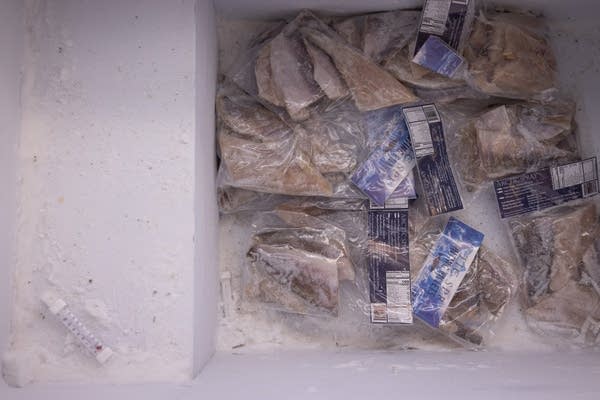‘Summer of hunger’: Food shelves struggle as high demand, low supply collide

Go Deeper.
Create an account or log in to save stories.
Like this?
Thanks for liking this story! We have added it to a list of your favorite stories.
Standing in the protein section at Rochester’s food shelf this week, Virginia Merritt pointed to a shelf dotted with jars of peanut butter and cans of chili.
“See how there's no shelves on the ends? That used to be full,” said Merritt, executive director of the Channel One Regional Food Bank.
Behind her, a case that once kept a variety of frozen meat now only offers one type of fish.
"We're rearranging the shelves to try to give that look of abundance, because we don't want people to worry that there isn't enough food,” she said.
Turn Up Your Support
MPR News helps you turn down the noise and build shared understanding. Turn up your support for this public resource and keep trusted journalism accessible to all.

This sleight of hand is meant to disguise that there's less food supply than there was even a few months ago. Meanwhile, more people are coming to the food shelf because inflation means they're paying more for basic expenses, Merritt said.
“You're going to pay your rent or mortgage, you're going to put gas in your car, you're going to pay your child care,” she said. “And then what gets further down the line where people skimp is the food."
This mismatch in food supply and demand is caused by a host of global economic pressures colliding at once: inflation and gas prices are high, so more people are using food shelves to make ends meet. Supply chain issues mean there are fewer donations from food manufacturers. And federal supports meant to keep people afloat financially during the pandemic are sunsetting.
"We could be headed into what could be the hungriest summer in history,” said Allison O'Toole, CEO of Second Harvest Heartland.
“Our supply chains are super tight. And so some of those staple products that we get — that are in high need and high demand at food shelves — they're just hard to source.”

‘It just hits harder’
Visits to Channel One are up nearly 40 percent since January — higher than the early days of the pandemic, Merritt said. In May, the food shelf exceeded 6,000 shoppers, a high water mark for the nonprofit.
Some are first-time visitors.
Amanda Maroo, who lives in Rochester, is among them. She was out of work for long stretches during the pandemic, and is now trying to use her psychology degree to develop a more stable career. Inflation and gas prices are affecting her ability to shop at the grocery store like she used to.
"With almost starting at square one, again, with everything costing more, it does just kind of hit harder," said Maroo.
Miranda Schmitz, a working mother of four who also lives in Rochester, recently returned as a food shelf client.
Schmitz says she's noticed that there's less to choose from at Channel One than there was before the pandemic.
"I was really shocked. There were about 10 loaves of bread,” she said. “And I'm like, ‘Well, I don't even want to take bread you know, what if somebody needs it more than I do?’"

Strain on food shelves is worse now than it was at the start of the pandemic, said O’Toole, partly because food supports are going away.
During the pandemic, people like Schmitz, who are on the cusp of needing free food, qualified for the first time for federal food assistance benefits when the SNAP program expanded eligibility. That temporary expansion is over now.
“It is a massive decrease, a premature decrease in this level of support at a time when we're starting to see the need increase to levels that exceed 2020,” said O’Toole.
Meanwhile, she said food supplied by the government for Second Harvest's region is down more than 50 percent. And donated food from food manufacturers is down too, indicative of global supply chain issues.
That’s especially true for high demand foods like meat, said O’Toole.
A specialized room in Second Harvest's food bank where they can defrost meat just enough to separate it for distribution around the region hasn't been used in months.
"We've done our work to increase our capacity, capabilities, sourcing — and things like [the cold room] are sitting idle just when our community needs it most.”
Inflation and supply chain woes
Food banks around the state are feeling this crunch.
Clients at Second Harvest North Central Food Bank in Grand Rapids, Minn., have told executive director Susan Estee that they have tried to find what they need at local stores, but groceries have become too expensive. They then drive miles and miles to the closest big box store only to find those stores are out of basic items.
"Now they spent the money on gas, and now they're at the food shelf,” Estee said.
Higher food prices and supply chain challenges cut both ways, said Estee. Food manufacturers are selling all they can to stores, which means less donated food to the food shelves. Food shelves are then spending more money on purchasing food for their clients.
Estee said more government food donations would help. Meanwhile, O'Toole wants the Minnesota Legislature to approve $23 million from the state's budget surplus to help food shelves.
Back in Rochester, Merritt said that the community was generous during the worst of the pandemic. But those community donations have dropped off.
"As we get back to a normal way of life, do people remember that their neighbors are still struggling?"


